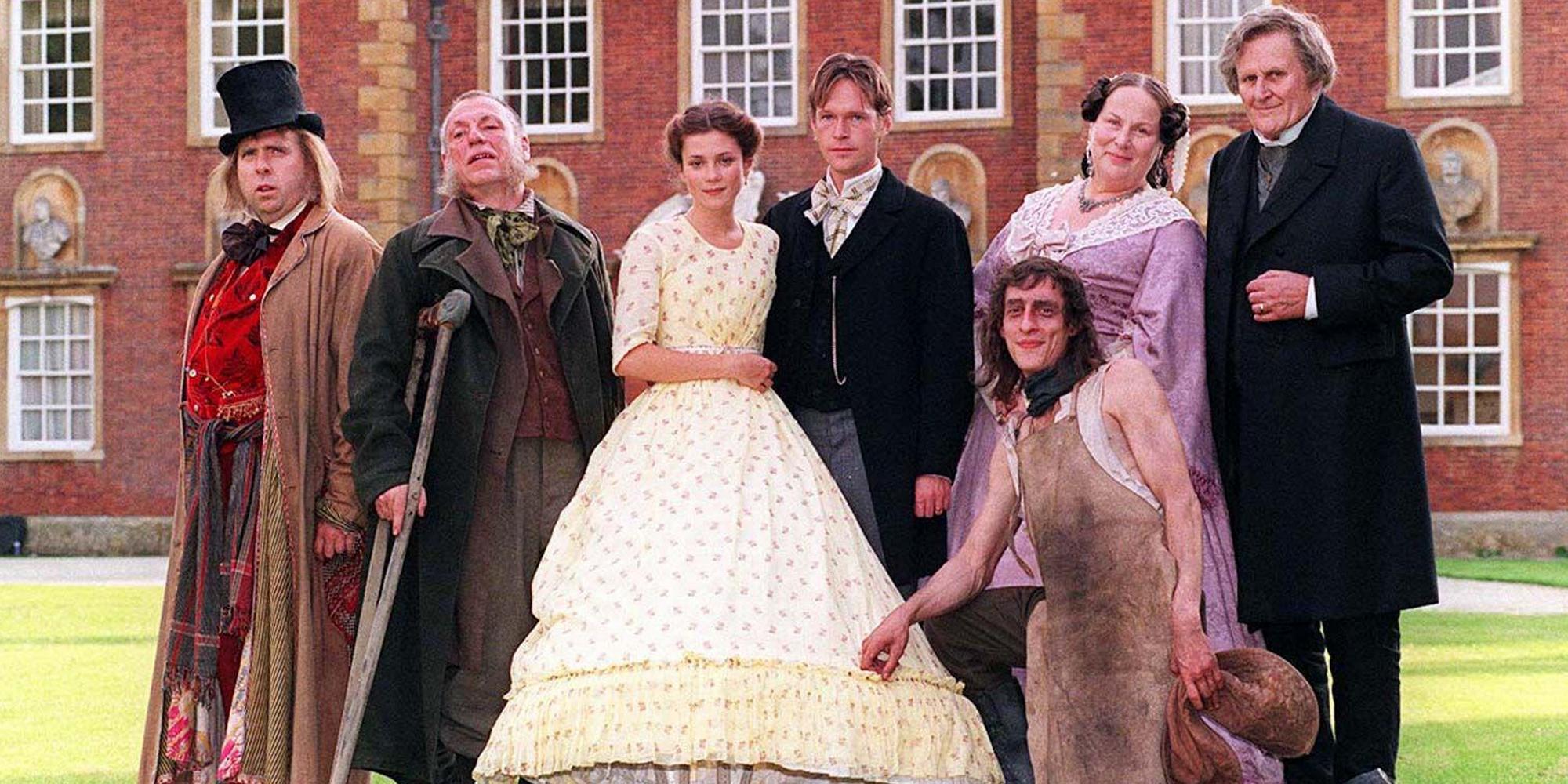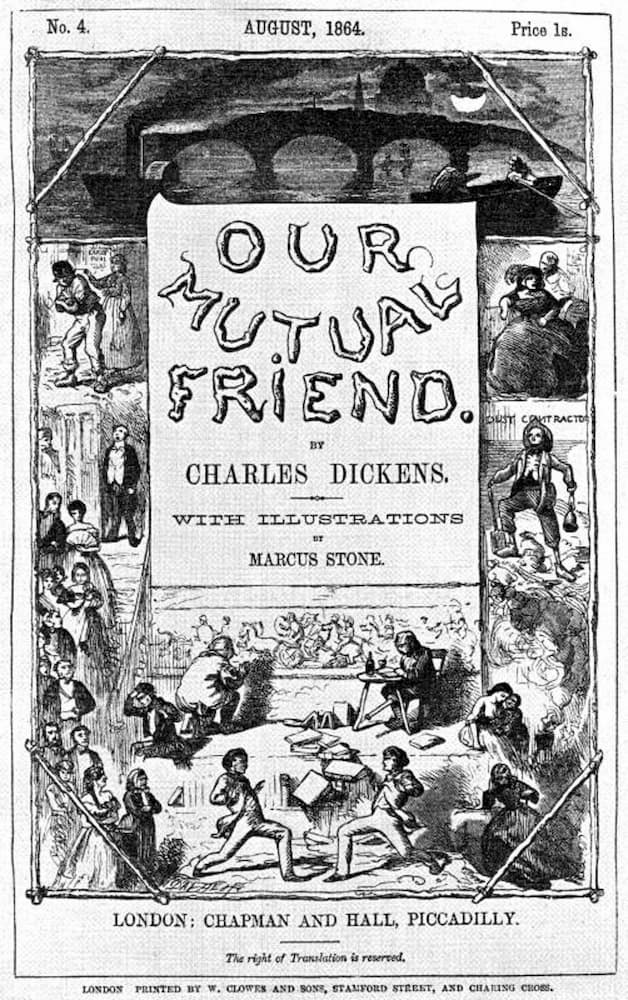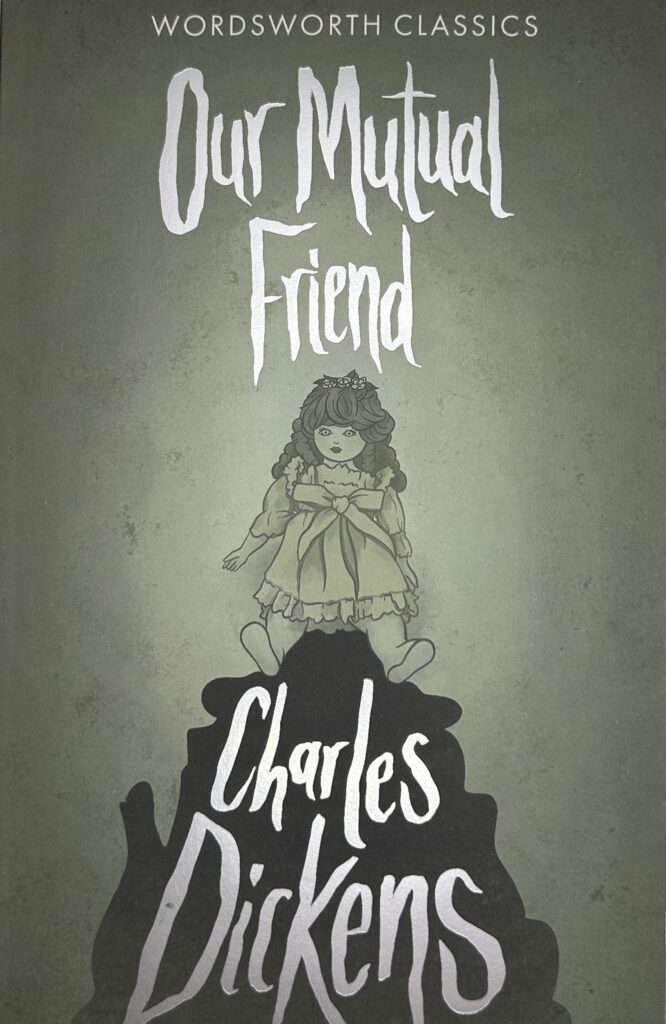
‘Money, money, money, and what money can make of life’
‘Money, money, money, and what money can make of life’
Our Mutual Friend, first published in 1864, was Charles Dickens’ last completed novel. This late work gives one of the author’s richest and most comprehensive accounts of modern society, as well as perhaps his bleakest. It is true to say that this is one of Dickens’ most sophisticated works, combining savage satire and social analysis.

The August 1864 Wrapper for ‘Our Mutual Friend’
As he aged, Charles Dickens grew less sanguine about life, prompted to some extent by his failing health. This is reflected in the tone of his prose and while there are still comic moments and characters in this swan song, such as those found in his first novel The Pickwick Papers, the tone is much darker and more serious. Dickens’ main aim in Our Mutual Friend is to present a vision of a culture almost stifled by materialistic values. This is not only illustrated by its central storyline, but also through its apparently incidental characters and scenes. There are, for example, the faded aristocrats and the nouveaux riche who gather at the Veerings’ dinner table who spout arrant nonsense and Betty Higden who fears the terrors of the workhouse and greedy plotting of Silas Wegg, ‘with a face carved out of very hard material.’
The central character in the novel is John Harmon, ‘our mutual friend’ who is promised a fortune by his father if he agrees to his wishes and marries Bella Wilfer, the daughter of his clerk. Harmon, who has been abroad and estranged from his father, is against the match. However, when John arrives back in England, he is attacked by robbers and dumped in the Thames. He escapes drowning but a man of similar build is found in the river and identified as John. He takes this opportunity to investigate the destiny that Fate has designed for him, deciding to take the name Julius Handford but later he changes it to John Rokesmith. In this latter guise he enters the employ of Mr Boffin as his secretary and eventually encounters Bella Wilfer. She has had her head turned by her belief that wealth is power, but with John’s influence she reforms, when she becomes aware of its evils.
The fact that John and Bella do eventually marry is by no means the end of their story, which threads its way through a colourful and intricate narrative containing many sub plots. So dense is the storyline that some of the original reviewers found it too complex to assess in detail. The New York Times was particularly harsh in stating that the novel had, ‘an involved plot combined with an entire absence of skill to manage it and unfold it.’
Dickens’ style was evolving further. It was as though he was experimenting with the form of the novel and it is only in the last hundred years that academics and reviewers have come to appreciate the different shading of the individuals that form the cast of Our Mutual Friend. Contemporary reviewers suggested that the characters were lacking the life and theatricality of Dickens’ earlier works, but now they are considered as a true representation of the Victorian working class and the key to understanding the structure of the society as depicted in the novel. In 1940, writer and critic Edmund Wilson wrote, ‘Our Mutual Friend … is more interesting today than it was to Dickens’ public. Certainly the subtleties and profundities that are now discovered in it were not noticed by the reviewers at the time.’

Leo McKern in the 1976 production
The greatest of Dickens’ later works focus on money and its corrupting influence. Dombey and Son and Bleak House both sound this strong note, but nowhere is it more forceful than in Our Mutual Friend. Regarding this novel, critic and reviewer Stephen Gill observed:
‘Sickened by the vanities of the railway era, and by the jingoism voiced through every organ of the Great International Exhibition, appalled by England’s wilful ignorance of the seamy foundations of Victorian prosperity, Dickens sounds his key-note, that money is dirt and death.’
The reference to dirt is connected with John Harmon for his father achieved his wealth as a dust contractor. It was the case that dust taken from dustbins was taken to dust yards on the outskirts of the city and owned by wealthy dust contractors. The resulting mountains of dust were very valuable. In linking dust with wealth, Dickens was able to make a pertinent point concerning the relationship of the two.
Because of the dense and complicated plot and the enormous cast of characters, dramatised versions of Our Mutual Friend have been thin on the ground. The first attempts were two silent movies in 1911 and 1921, both of which presented extremely simplified versions of the story. There have been no other movie versions, but there are three BBC Television versions.
The first came in 1958 and ran for twelve episodes and remarkably, unlike most BBC series of the 1950s, it still exists in its entirety. Released on DVD in 2017 by Simple Media, it is still available to buy. The cast includes some famous names of the day, including Rachel Roberts, David McCallum and Wilfred Bramble.
The second BBC production in 1976 excluded a number of minor characters due to the limitations of a seven-episode structure but it was praised for reproducing the mood and atmosphere of the novel. This version, starring, amongst others Jane Seymour and Leo McKern, is also available on DVD as is the 1998 adaptation starring Paul McGann and Keeley Hawes, which won a BAFTA for best drama serial.
It is quite amazing to consider that all of Dickens’ novels have been filmed for the cinema or the television screen. Quite an achievement for an author and no doubt that this is because, despite their historical setting, Dickens presents humanity in all its shadings, triumphs and dilemmas. Periods and fashions may drift away, but the travails of the human heart are constant and Our Mutual Friend provides a shining example of this phenomenon.
David Stuart Davies
Main image: The cast of BBC’s ‘Our Mutual Friend’ during filming in Warwickshire. (l-r) Timothy Spall, Kenneth Cranham, Anna Friel, Steven Mackintosh, Pam Ferris, Peter Vaughan and in the foreground Martin Hancock. Credit: PA Images / Alamy Stock Photo
Image 1 above: The August 1864 Wrapper for Our Mutual Friend. Credit: The Picture Art Collection / Alamy Stock Photo
Image 2 above: Leo McKern in the 1976 BBC production. Credit: Everett Collection Inc / Alamy Stock Photo
Books associated with this article
